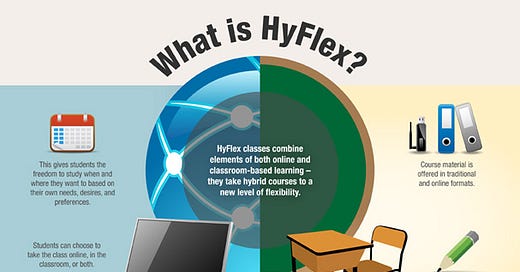Tip: "HyFlex" - Hybrid Flexible blended models
The HyFlex model combines F2F and online learning in a flexible course structure that gives students the option of attending sessions in the classroom, participating online, or both.
As we look toward the fall and beyond, flexibility in course design seems to be the key, but flexibility paired with maintaining high standards, meeting students where they are, and providing equitable access to course materials and activities. What the fall semester will look like, logistically, is far from being ironed out, but as we think through all the alternatives and think about how the puzzle pieces will come together in different ways to impact our students, there are some certainties. It seems highly likely that, while we may hope for some on-campus activities and meetings, we will need to be prepared with virtual activities as well. What will we do if a student becomes ill or needs to self-quarantine? Or if we do? What if we start the semester remotely, and then switch to online delivery, or the opposite? It’s hard to plan for every possible outcome - and not realistic to think that we would have multiple versions of each course, ready to roll in August - but there are design choices we can start to make now that will help us to navigate these outcomes.
To prepare for the most flexible course design we can, given our particular disciplinary and course delivery constraints, it might be worth looking into hybrid-flexible, or HyFlex, course design principles.

In a 2019 book, Hybrid-Flexible Course Design: The Faculty Experience in HyFlex, the author explains that:
In Hybrid-Flexible (HyFlex) classes, students are typically given full control over their decisions to participate online or in the classroom. This provides them with the ability to make participation choices based on convenience, learning progress, social interaction preferences, or other factors important to them at the time. Faculty…have to provide both an online and a classroom experience supporting student learning.
While a white paper, Seven Things You Should Know About the HyFlex Course Model (Educause, 2010) explains that the HyFlex model of course design:
presents the components of hybrid learning (which combines face-to-face with online learning) in a flexible course structure that gives students the option of attending sessions in the classroom, participating online, or doing both.
This sounds, frankly, challenging. However, as I sat and thought more about what this model would truly look like in my classes, I decided to consider just one typical assignment (or task) my students complete, and drafted the following broad strokes…
Task: Write an essay draft (broken down into 5 sub-tasks with both sync. and async. components AND choice components).
Preparation work/Homework (async.): Read through assignment expectations/instructions handout.
Pre-recorded material (async.): Watch a 10 minute video demonstrating an outlining technique.
Sub-task (async.): Create an outline draft.
Sub-task (group work completed sync. online OR in-person OR async.): Peer review the outline draft using a rubric/list of things to look for.
Whole class session (sync. online OR in-person OR viewed async.): 30-45 minutes reviewing several examples of outlines and improving them together as a class (perhaps in a shared google doc).
Sub-task (async.): Revise outline draft.
Preparation work/Homework (async.): Watch a 10 minute video demonstrating how to expand from an outline to drafting body paragraphs.
Sub-task (async.): Draft body paragraphs.
Sub-task (group work completed sync. online OR in-person OR async.): Peer review the body paragraphs using a rubric/list of things to look for.
In a normal semester of a hybrid course, I would probably assign item #1-3 for pre-class meeting work, complete #4-6 in class together, and then have the students work through #7-9 as their “online” part of the week. (If I was teaching an entirely F2F class, I would probably cover most of #1-7 in class, with #8 for homework and #9 for the next class meeting.)
This is an extremely rough outline - more a thought experiment than a finished plan - but I hope that it gives you something to react to as you think about how to structure your fall courses in our ever-shifting demands.
If you want to explore more about HyFlex course design, there’s more being published every day. Here’s a curated list of resources:
Blended Synchronous Learning Handbook - collection of case studies that investigated how rich-media technologies such as web conferencing, desktop video conferencing and virtual worlds could be used to effectively unite remote and face-to-face students in the same live classes.
Here’s an interesting article reviewing a research study that showed how little students actually participated in synchronous live class meetings - they would choose either in-person meetings, or asynchronous activities, over synchronous meetings.
For the community college context, here’s a helpful HyFlex course development guide created by SUNY Genesee Community College (2019).
And, if you are still interested in more reading, here’s a document with a large collection of resources (articles, websites, etc) I collaborated on with folks in the POD network.

PS: Next up - Zoom & why it’s not always the perfect solution…



